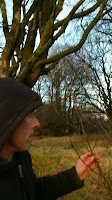
Planting the Gaps in a Beech Plantation
Beeches are beautiful native trees, beneficial to many forms of wildlife. But all too often they are planted in these hideous monocultures, where little grows under them, due to their acidic leaf mould. In a mixed deciduous woodland, which includes the right natural balance of Beech; wild flowers thrive, but under just Beech very little will grow. Wild Daffodils certainly will not.
 On Dartmoor there are many of these Beech Plantations, they have little extra plant life in them than a conifer plantation. There are few examples of mature native trees up here and the Beech have grown into Bonsai versions of what they would have been, if they were growing in the lowlands. These trees seldom get above60 feet/20 metres due to the high altitude and poor acidic soil conditions.
On Dartmoor there are many of these Beech Plantations, they have little extra plant life in them than a conifer plantation. There are few examples of mature native trees up here and the Beech have grown into Bonsai versions of what they would have been, if they were growing in the lowlands. These trees seldom get above60 feet/20 metres due to the high altitude and poor acidic soil conditions.Falling Trees
 The pictures here show the Beech tree plantation, which is situated in the middle of one of my woods. The ground here is semi boggy and often the great trees topple over in the soft wet ground, under their own weight. Very often they can regenerate, but nothing like as well as Willows can.
The pictures here show the Beech tree plantation, which is situated in the middle of one of my woods. The ground here is semi boggy and often the great trees topple over in the soft wet ground, under their own weight. Very often they can regenerate, but nothing like as well as Willows can.These trees are very old and each occupies quite a large chunk of the canopy. Each time one of them falls down it provides a new area for me to plant, with a more balanced next generation of small trees.
Preferred Tree Types
 I find that most species of shrub tree have difficulty growing on a site, where Beech has the only major in-put into the available leaf mould. Most shrub trees remain stumpy for years and Birch really does not do well either.
I find that most species of shrub tree have difficulty growing on a site, where Beech has the only major in-put into the available leaf mould. Most shrub trees remain stumpy for years and Birch really does not do well either.What I call ‘the main sequence trees’, such as Oak, Ash, Lime, Alder, Sweet Chestnut, Elm and Beech all seem to grow very well, in these gaps and don’t seem at all bothered by any harshness of conditions brought on by any toxic qualities in the leaf mould from the Beech, so they are what I have planted in here.




No comments:
Post a Comment